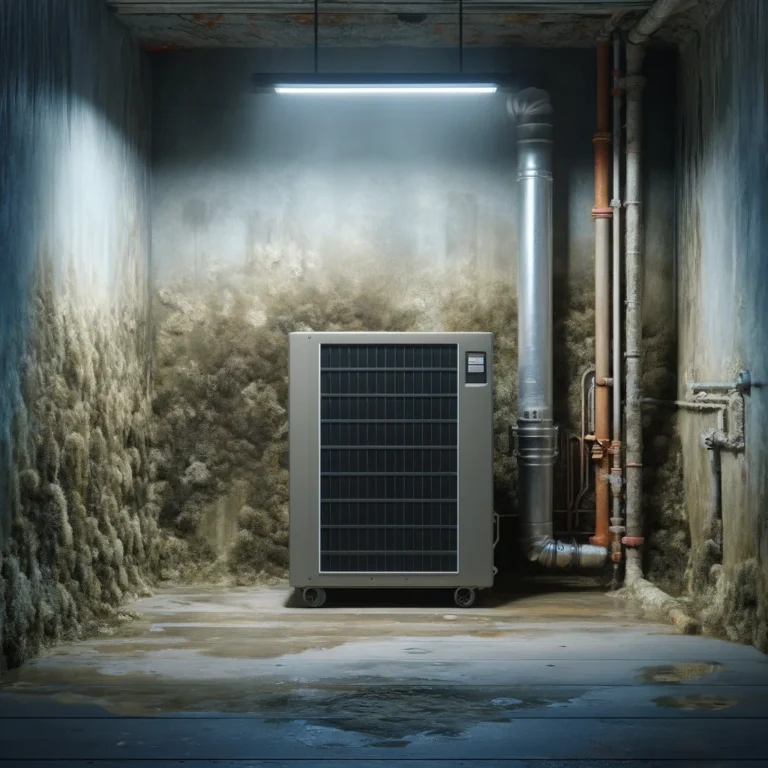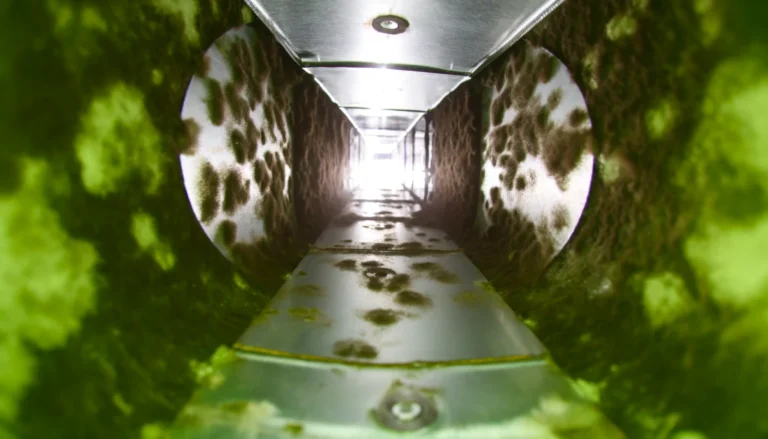

by Dr Diane Mueller – Stepping into a cool room on a hot day is a relief, but did you know your air conditioner could be harboring a hidden danger? We’re talking about black mold. This greenish-black substance, scientifically known as Stachybotrys chartarum, thrives in damp, dirty environments.
We’ll cover the dangers of black mold in air conditioners due to accumulated dust and debris, which can adversely affect indoor air quality and pose health risks. The piece explores how black mold proliferates and provides guidance on its effective removal.
We have helped thousands of people restore their health and quality of life by diagnosing and treating their Mold Illness
Black mold, also known as Stachybotrys chartarum, is a particular type of fungus that poses significant health risks if allowed to proliferate. This section sheds light on why your air conditioner is a comfortable environment for black mold and discusses the potential dangerous effects.
Air conditioners can be a breeding ground for mold spores and especially black mold. These units usually create moisture which can encourage the growth of black mold. The mold spores find the damp and dirty environment of an air conditioner to be perfect – it’s exactly right for them to thrive.
Materials such as lint, gypsum board, paper, fiberboard, and dust that get stuck in the AC unit act as food for the mold. Without proper maintenance and cleaning, your AC unit can unknowingly become a hub for mold growth. This explains why it’s crucial to clean the filters regularly and ensure your air conditioner unit doesn’t accumulate excess moisture.
The short answer is, yes. Mold in an air conditioner can not only compromise the overall air quality within your home but also pose serious health risks. The term “toxic mold” isn’t just a figure of speech.
Black mold exposure can lead to a long list of health problems. Once it gets into your air conditioning system, it won’t be long before the spores reach your home’s air ducts. This can lead to a spread throughout the house, increasing the chances of health issues.
Signs You May Have Black Mold in Your Air Ducts
Black mold infestation can manifest through various signs, both in your air conditioning unit and in your health. A clear indication is a distinct musty or mildew-like smell permeating specific rooms or even your whole house. This odor typically intensifies when your unit is turned on.
Appearance of black dust around air vents and visible presence of mold in different colors (typically black, but may also be found in shades of brown, green, white, pink, yellow, or orange) are blatant signs of mold in your AC. The mold stains are often present on air ducts, air filters and along surfaces with high exposure to moisture such as shower walls, floors, and ceilings.
Also, these spores are not always easily detectable. They can stealthily thrive on or behind damp drywall, and in hidden, hard-to-reach areas of your home. Regular maintenance and diligent inspection of your air conditioning system are necessary to prevent a severe mold issue from lurking unaddressed.
You should consider testing for mold – as much of the mold is not visible. At home options are cost effective and the two to consider are HERTSMI–2 Mold Test and ERMI Mold Test. EnviroBiomics is a well established company for home mold tests.
Mold thrives in a moist, dark, still air and warm environment. Your air conditioning system becomes mold’s haven by conveniently producing condensation, stirring up poor air movement and high humidity, especially if there are malfunctions such as a clog in the condensate drain.
Also, air vents with their dark and undisturbed areas help the sustenance and spread of mold into your air conditioning unit. These areas are potential origins of mold contamination that require your vigilant attention.

If you discover black mold growing in your air conditioner, you need to handle this issue promptly. But, before diving into the cleanup process, first determine whether you should hire a professional or try a DIY approach.
If black mold has infested big enough area of your AC system, it’s strongly advisable to hire a professional. While costly, black mold from sizeable units requires specialized skills to ensure complete removal without causing further hazards.
The right professionals are trained to handle the job effectively, reducing the risk of mold spread during the removal process. They have the right equipment to reach hidden parts of the HVAC system and the experience needed to navigate complex components.
While there are DIY options, please take necessary precautions (gloves, mask, ventilation, eye protection). You can remove mold from a wall-mounted or window AC unit yourself. But, dealing with mold, especially black mold, brings certain health risks.
If you decide on the DIY route, make sure to use adequate personal protection equipment and use the right cleaning solutions. Always follow instructions and don’t rush the process. Remember safety first, and don’t underestimate black mold’s impact on your health.
Regular Maintenance is like brushing your teeth – you gotta do it regularly. What’s the first simple thing you can do? Change that air filter! A nice, clean, top-notch filter does two things: saves your HVAC from unwanted junk and stops the perfect playground for mold from forming. Ideally, swap out that filter every 60-90 DAYS or follow what your unit’s maker suggests.
Next, check if your system has sprung any water leaks. Water leaks are like welcome mats for mold to come party, so they need taken care of ASAP. And let’s not forget about keeping the area around your AC unit spick-and-span too. A clean space makes it hard for mold spores to crash into your system.
Maximizing air circulation around your AC unit plays a significant role in mold prevention. This action, paired with suitable indoor ventilation, ward off moisture build-up that is an invite for mold accumulation. Adequate airflow can reduce indoor humidity levels, which in turn inhibits mold advancement. So, you must invest in creating regular and steady airflow to keep the black mold at bay.
When it comes to inhibiting black mold growth, moisture is the enemy. Hence, maintaining low humidity levels within your indoor environment should be at the top of your checklist. If your home has a central humidifier, it’s best to either keep it off or remain vigilant. Change its water filter routinely to prevent fostering a damp atmosphere.
Considering the potential health risks associated with black mold exposure, it is crucial to take all necessary steps to maintain a healthy, mold-free environment. Utilization of dehumidifiers is also worth considering, especially in seasons of high humidity. These devices effectively remove excess moisture from the air, making it less conducive for black mold growth. Your continuous efforts to manage and monitor indoor humidity levels provide a strong blockade against the invasion of unwanted mold.
So, you’ve now got the scoop on stopping black mold in your AC. Remember, it’s all about taking care of that unit and keeping those humidity levels in check. Don’t overlook the power of a fresh air filter or how important it is to keep an eye out for any water leaks. These easy steps can make a huge difference in keeping your place mold-free. And hey, don’t forget, good ventilation is like your BFF when it comes to stopping mold growth. So go ahead and take charge, crank up that dehumidifier, and create a healthier environment for yourself and your family. The ball’s in your court now. Keep that nasty black mold at bay and breathe a sigh of relief knowing you’re doing your bit to keep a healthy home vibe going.
References:
Curtis, L., Lieberman, A., Stark, M., Rea, W., & Vetter, M. (2004). Adverse Health Effects of Indoor Moulds. Journal of Nutritional & Environmental Medicine, 14, 261-274.

We have helped thousands of
people restore their health
and quality of life by diagnosing
and treating their Lyme Disease.
“Dr. Mueller’s approach to medicine is refreshing! There is only so much you can do with western medicine and in my life I was needing a new approach. By addressing the whole body, nutritional diet factors, environmental factors, blood work, and incorporating ideas I had not previously known, I was able to break through with my conditions. I am not only experiencing less pain in my life, but through the process of healing guided by Dr. Diane Mueller, I am now happy to say I have more consciousness surrounding how I eat, what to eat and when things are appropriate. Living by example Dr. Mueller has a vibrancy that makes you want to learn and know more about your body and overall health. I highly recommend her to anyone looking for new answers, a new approach to health, or in need of freedom from pain and limitations.”
-Storie S.
Kihei, HI
